Introduction
The topic of French cruisers could be summup in a few points: It was framed by the Washington treaty limitations, a situation causing a de facto rivalry with Mussolini’s Italy. Like their Italian counterparts, the accent was placed on armament and speed, not protection. They were part of the “tin-clad cruisers” generation. Compared to the global tonnage of other countries, they were relatively modern (no ww1 cruiser in service) and had some innovative features like the La Galissonière class transom stern or the Mack on the Saint Louis.

An overview of individual French cruisers with various liveries.
They remained largely untested in combat, due to the early capitulation and a limited use by the FNFL (Free French Naval Forces) for coastal bombardment and patrols. In a general way, they also had a relatively poor AA, relying on machine guns and dual purpose ones without much in between. WW2 modernization would be the occasion to improve on that, based on US standards. The tonnage cap and subsequent treaties was dissuasive: At first, France started a serie of light cruisers to test superfiring twin turrets, after a gap of 15 years (since 1908).
Indeed, the planned construction of new cruisers dated from 1912, was never realized (see later). After the Duguay Trouin “test”, the Duquesne and Tourville classes were homogenous heavy cruisers, but in 1931 it was realized protection was needed, and the Algérie was built, sole in her class as France was stopped by the London treaty whereas Italy had the time to complete its four Zara. Capped for heavy cruisers, like in other navies, the 1930s saw the exploration of light cruisers, the “prototype” Bertin, and the La Galissonnière serie, followed by the unbuilt De Grasse and Saint Louis class as the war started sooner than expected. Alongside were also built two specialized cruisers, the Pluton for mine warfare and the school cruiser Jeanne d’Arc.
The war largely split these cruisers into those who would remained trapped under Vichy’s base and those which could swap sides in due time (November 1942), and continue the war until the end. See the French cruisers in action.
Origins
Development for the the cruisers lineage started in 1909 in fact, not in 1919, where planning for a class or scout cruisers was decided. In 1912 a grand naval plan was decided to get rid of the “young school” theories which had left the Navy in a situation of having odd ships with limited homogeneity, an emphasis on armoured cruisers and torpedo boats, at first influenced by the possible scenario of a war and confrontation to the British Royal Navy, at least twice larger. The launch of HMS Dreadnought stopped dead cruiser development in France as shown in the previous article on WW1 French cruisers. The 1912 conducteur d’escadre (flotilla leader) was born.
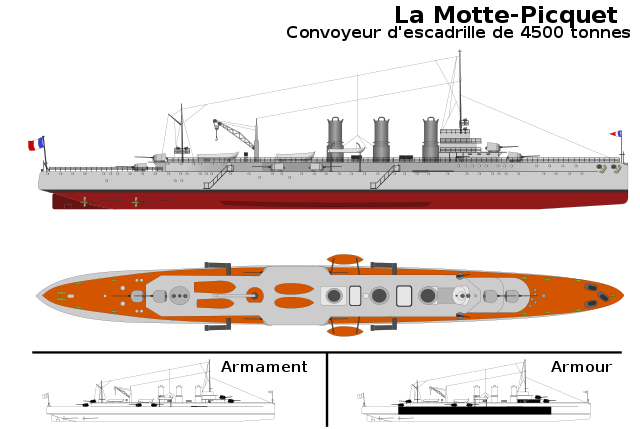
The 30 March 1912 naval law and program defined an ambitious plan of building 28 battleships, 10 scout cruisers and 52 fleet torpedo boats, with an ideal completion date for around 1920. Of course the war breaking up in 1914 shattered these plans and “La Royale” had to make due with the “old fleet”, with dreadnoughts just completed, others in construction and for cruisers, just a paper project. As manpower was depleted from the yard to be sent on the front, construction focused on the most important ships and shifted towards lighter vessels. Cruisers were sacrificed.
The 6,000-tonne fleet scouts would have been relatively similar to the British Arethusa class and later evolved to include features influenced by the Karlsruhe and Magdeburg classes.
The “old hulls”
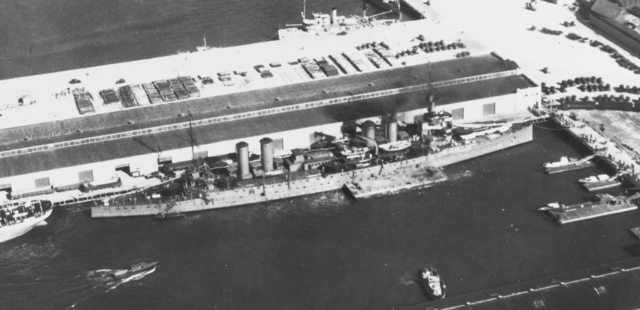
Edgar Quinet as a training ship in San Diego, California, 1928
The interwar saw the survival of partly disarmed cruisers dating back from 1892 to 1908. Some actually survived until the late 1930s and many saw WW2. The latest were actively used for some more years, well into the 1930s. Their large hulls and 13,000 tonnes displacement made them suitable for further conversions/modernizations, but they never took place because of global cruiser tonnage issues. It could have been interesting to see them converted during WW2 as AA floating batteries, such as the Italians did with their San Giorgio class.
These old cruisers were the:
-La Touche Tréville (1892): Discarded 1926
-Pothuau (1895): Discarded 1929
-Cassard (1896): A 3890 tonnes light cruiser, sticken in 1924.
-Jeanne d’Arc (1899): Discarded 1934 (actually France’s main school cruiser until her replacement by her namesake).
-Gueydon (1899): Utility Hulk until 1942
-Montcalm (1900): Discarded 1933
-Desaix (1901): Discarded 1927
-Condé (1901): Discarded 1933
-Marseilaise (1900): Discarded 1929
-Jules Ferry (1902): Discarded 1927
-Victor Hugo (1904): Discarded 1930
-Jules Michelet (1905): Discarded 1937
-Ernest Renan (1906): Discarded 1931
-Edgar Quinet (1908): Wrecked in 1930
-Waldeck Rousseau (1908): Hulked 1936.
Here are samples of their interwar and ww2 career:
Montcalm was decommissioned and an accommodation ship from 28 October 1926, renamed Trémintin in 1934, in Brest and sunk by the RAF on 16 August 1944.
Condé was reduced to special reserve on 15 March 1920 and barracks ship for Fusiliers Marins from 1922 in Lorient (Britanny). From 1928, she hosted the Naval Infantry School and was stricken in February 1933 but still used during WW2 as a torpedo depot ships by the Germans.
Marseillaise was a gunnery training ship at Toulon in 1925–1929 and scrapped in 1933.
Jules Ferry served in the far Eastern Division from September 1923, to her return to Toulon in November 1925, placed in reserve and stricken 1927, scrapped 1928. Her fate was similar to Victor Hugo.
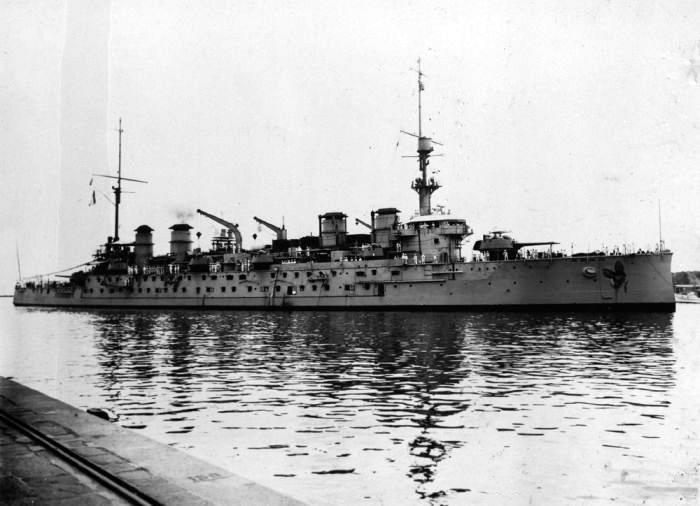
Jules Michelet during a state visit of the Dutch General Governor at Tandjong Priok, 1929. She was the flagship of the Eastern Squadron.
Jules Michelet was based in French Indochina in 1922–1923 and returned home in 1923 and returned in Asian waters until May 1929, replaced by Waldeck-Rousseau. Placed in reserve she was disarmed and used as barracks ship at Toulon and target ship later for aircraft and submarines. She was actually sunk by the submarine Thetis in 1937.
Ernest Renan saw her mainmast removed and she was modified as a towing balloon vessel and AA floating battery, and later a gunnery training ship from 1927 to 1929, training notably Émile Muselier, future commander of the Free French Naval Forces. She ended as a target ship in 1931.
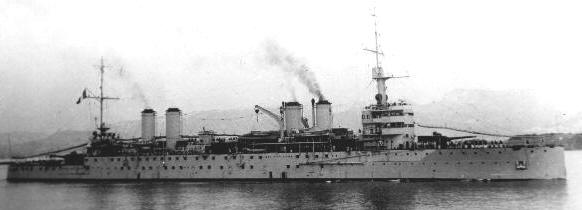
A better view of the Quinet in 1937, showing the modified bridge (http://ecole.nav.traditions.free.fr/jeannedarc.htm)
Edgar Quinet served in the Mediterranean Squadron 1923-1924, and reduced comm. in Toulon, and from 1925, converted into a training ship. She briefly replaced the much older Jeanne d’Arc. Until 1927 she only had ten 194 mm guns left (two funnels removed and boilers removed) and a rebuilt and modernized bridge. From 1928 she was training ship for cadets at the Naval Academy and under command of Captain François Darlan made a world tour, as far as California. In 1929 she was overhauled again, equipped to handle reconnaissance floatplanes. However her career could have bring her in WW2, until she was foundered on 4 January 1930 off the coast of Algeria, west of Oran.
Waldeck Rousseau was in the reserve fleet, Toulon in 1922 until April 1929, recommissioned for a tour in East Asian waters and replaced Jules Michelet as flagship of the French Far East Squadron until May 1932, when relieved by Primauguet. She was decommissioned and in reserve until June 1936, stricken and converted into a hulk at Landévennec, outside Brest, and a breakwater in WW2.
The war prize cruisers
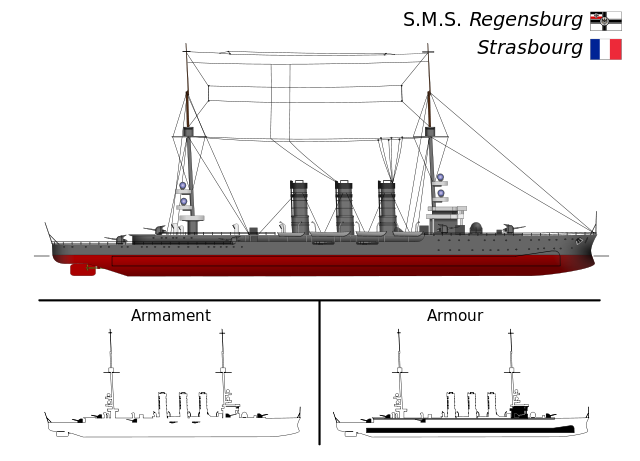
The Strasbourg (ex-Regensburg).
Of course after the victory in November, The French admiralty considered the options. The light cruiser project was still favoured, but became influenced by the transfer as war reparation, of modern German and Austrian cruisers. On November 26, 1919, France was authorized by the Allied Council to choose five cruisers and 10 torpedo boats in this wealth of “war prizes”. The German light cruiser Königsberg (ii) was renamed Metz and the Regensburg renamed Strasbourg, the Stralsund Mulhouse and the Kolberg Colmar, while the light Austro-Hungarian cruiser Novara was renamed Thionville.
-Colmar:
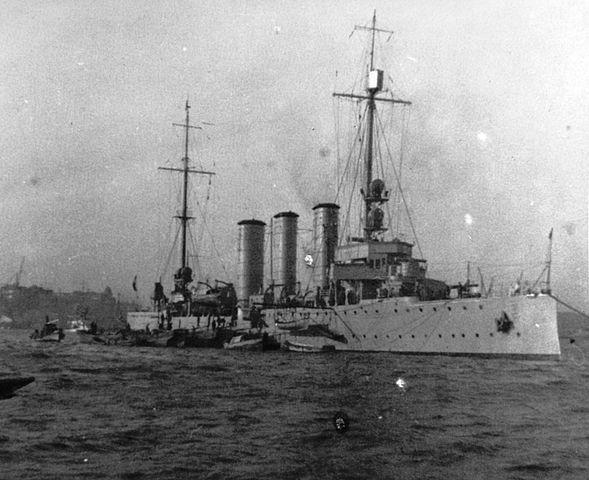
SMS Kolberg was stricken on 5 November 1919 and handed to the French in Cherbourg on 28 April 1920 as “W”. She was recommissioned as Colmar in 1922, her original 8.8 cm guns replaced by 75 mm ones. A new aft deckhouse was built and an extra 75 mm gun installed on its roof. Her sea trials lasted until late 1922, and she was sent for colonial service in French Indochina, departed in June and arriving on 7 September 1922. She replaced Montcalm as flagship of the Naval Division of the Far East and was sent in Vladivostok in 1923 after the Great Kantō earthquake, proceeding to Yokohama to assist in the relief effort with Jules Michelet, Victor Hugo, and Jules Ferry. In 1924, Colmar and Jules Ferry also landed troops to protect western interests during the violence in Shanghai. Colmar was back in France in February 1925 and lasted in service a few more months, until decommissioned in November. She was cannibalized until 1927, for the other ex-German cruisers until and stricken on 21 July 1927, sold for BU.
-Mulhouse:
Stralsund served briefly with the reorganized Reichsmarine in 1919 but the Treaty of Versailles asked her to be disarmed and handed over to the Allies, two months before the signing, pending attribution as war reparation, which was France under the transaction name “Z”. She was formally handed over in Cherbourg on 3 August 1920 and had her 8.8 cm replaced by 75 mm (3.0 in) anti-aircraft guns but her apperance stayed the same. As “Mulhouse” ashe served in the French Mediterranean Fleet (3rd Light Division) with Metz, Strasbourg and Thionville.[ Mulhouse was refitted in 1925 in Brest as her powerplant was worn out, but it was soon established sue to her age it was preferrable to place her in reserve, which was done after the refit. On 15 February 1933, she was stricken and BU in Brest in 1935 but her bell was later returned to Germany (now at Laboe Naval Memorial).
-Strasbourg (1922)
SMS Regensburg once attributed and received by the French Navy was renamed Strasbourg from 1920. To standardize her armament, she was given a new battery of French 75 mm (3 in) AA guns in place of the usual German 8.8 cm guns. Aso her aft superfiring 150 mm gun was remove and a single 75 mm gun installed in its place for extra AA. Commission eventually was completed by 1922. She served at first in Brest, but was transferred to Toulon in 1923, until 1926, in service with Mulhouse, Metz and Thionville, called the 3rd Light Division, and and Light division in December 1926. Her major overhaul came about in 1925 and her boilers were cleaned up and upgraded, all worn out components replaced. She made 26 kn (48 km/h; 30 mph) on her post-refit speed trials. She was sent to support troops in the Rif War landings on 7 September 1925, with Metz and the battleship Paris. By 1928, she brought aid to the victims of the Corinth earthcake and later searched for the wrecked airship Italia northeast of Svalbard, also looking for Roald Amundsen’s aircraft which went missing too. Her bow was to be protected by wooden planking to protect it from pack ice. She also operated two FBA 17 seaplanes in the effort. On 30 August, at last she located one of the floats from Amundsen’s aircraft, but she wrapped up on 17 September and returned to Brest via Reykjavík. From 1928 to 1934 she resumed her Mediterranean service, renamed “Strassbourg II” that year as a new battleships was just launched under that name.
She was back in Landévennec and Brest and in January 1936, moved to Lorient to be stationed as a depot ship for the 6th Destroyer Division. By June she was stricken, placed in reserve but not scrapped. The irony was that after the fall of France, she was back into the hands of their ancient proprietor, and they briefly considered restoring her to active service or used as FLAKschiffe. But she ended as a barracks ship in Lorient for U-Boat crews, moored next to the U-boat pens. Barrage balloons and anti-torpedo nets were installed from her. In 1944, she was scuttled in front of the pens to protect them from torpedo attack and remains in the harbor up today, visible at low tide.
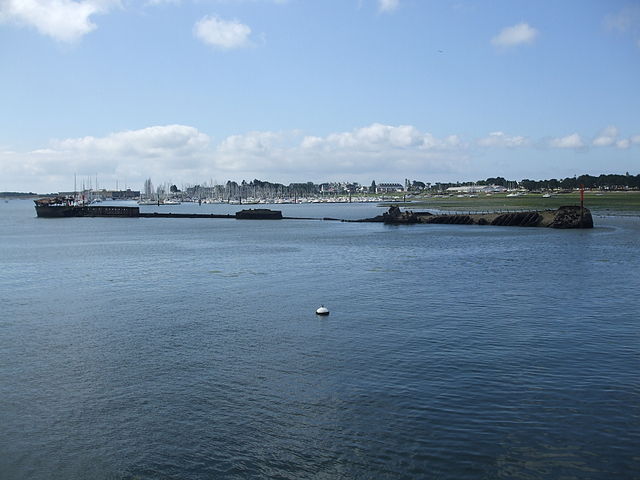
The hull of the ‘Strassburg’ in lorient as of today.
-Metz:
Königsberg (1915) was stricken on 31 May 1920 and ceded to France as “A”. Received in Cherbourg on 20 July, she was renamed Metz on 6 October and her 8.8 cm guns were replaced by standard 75 mm (3 in) anti-aircraft guns in French service, submerged torpedo tubes removed and above-water tubes replaced by 60 mm (2.4 in) tubes of French manufacture. Externally there was no change. Recommissioned in November 1921, Metz joined Atlantic Light Division, and then the French Mediterranean squadron by early 1922. She will serve with Mulhouse, Strasbourg and Thionville as part of the 3rd Light Division. In October, she carried Henry Franklin-Bouillon to Turkey for the negotiations of the Treaty of Lausanne. From 1925, she participated in the Rif War, covering landings on 7 September 1925 with Paris and Strasbourg. She was back to the French Atlantic Fleet in 1927-28 and stationed in Brest, while her division was dissolved and her aft funnels and main mast were removed. In 1929, she was sent to Landévennec in reserve and eventually stricken on 18 August 1933, sold in 1934, caught fire but was scrapped in 1936 at Brest.
-Thionville:
The SMS Novara suvived WWI and waited her post-war fate. In 1920, under the terms of the Treaty of Saint-Germain-en-Laye, she was surrendered to the Allied and awarded to France. However during her transfer to Itaky, she started to leak badly in the Adriatic but reached Brindisi, she sinking in the harbour on 29 January 1920. She was refloated by early April 1920 and sent to France, Toulon, where she was renamed Thionville. She assigned to the torpedo school until 1st May 1932, disarmed and converted into a barracks ship. She was still there by 1941, but later broken up for scrap.
The light cruiser program
Apart Metz which had 15 cm guns, these light cruisers were all armed with light (100-105 mm) shielded guns in single positions, but this force constituted at least until 1925 the core of the light cruiser fleet. At last in 1922, a naval program was established right after the conclusions and signature of the Washington treaty. Tonnages and gun caliber limitations has been setup and soon was voted the construction of three scout cruisers, of 8,000 tonnes. The first design of such cruisers in France since 1912, a ten years gap.
Therefore, the French started with light cruisers, before engaging in the construction of the brand new “heavy cruiser” class defined by the 1922 treaty. The light cruisers registered in the prewar programme, but new additional tasks were given which rose their tonnage considerably compared to the WW1 cruisers generation.
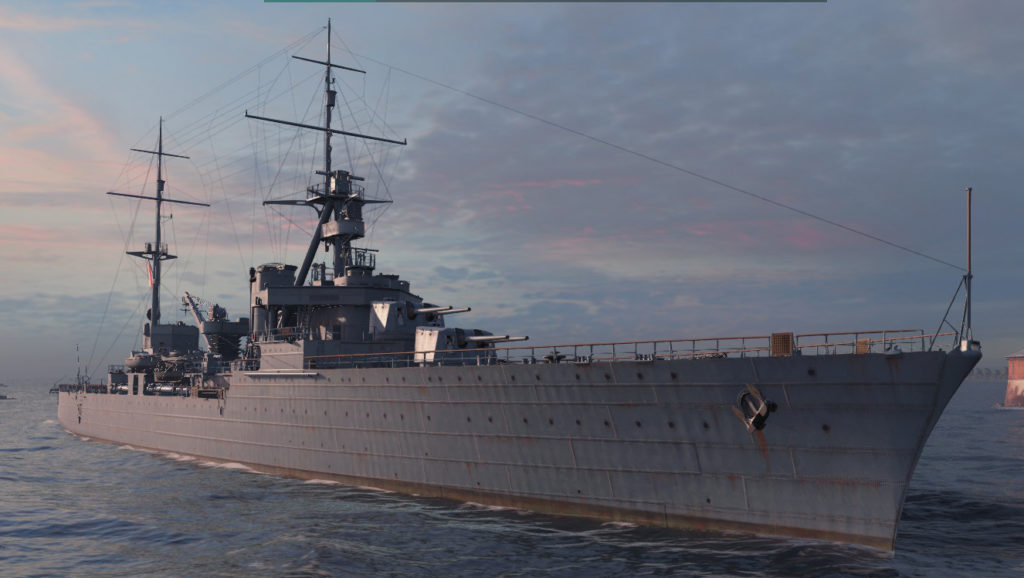
WoW’s “Friant” is a known fake to fill the lineage. Nothing in 1920 was ever drafted resembling to this, as it looks like a compact version of the Primauguet class, with a roomy hull and unlikely alleged power of 20-25,000 hp, no protection, for a speed as low as 23 knots.
The true light cruiser program, started in 1919, ended with the design of blueprints in 1920 which were relatively advanced for their time, compared for example to British designs like the Hawkins and Enterprise class, still armed with single masked guns, but already introducing twin turrets, as with the more comparable Omaha class.
The use of the new 1921 pattern 155 mm guns (unusual as the largest bore in the loose “6-in” range) in four twin turrets from the start was indeed quite a novelty, and quickly imposed itself later as an evidence as it maximized the firepower at all angles. Nevertheless, they were the first cruisers in the world with this configuration.
The design of the bridge was rational, centered around the conning tower, with open “wings” for observation, a roomy hull which authorized for ample machinery, allowing a speed in the range of 30 knots, justifying their place in the fleet as scouts.
Armament of French cruisers
We will exclude from this pre-ww1 designs and entente-built war prize cruisers.
-8 in/50 (203 mm) modele 1924 (Duquesne, Suffren, Algérie)
-8 in/55 (203 mm) modele 1937 (St Louis)
-6.1 in/55 (155 mm) modele 1921 (Duguay Trouin class, Jeanne d’Arc)
-6 in/50 (152 mm) modele 1930 (Emile Bertin, La Galissonière, De Grasse)
-5.5 in/40 modele 1927 (in single mounts: Pluton)
-3.9 in/50 modele 1931 DP (100 mm) (Algérie, St Louis)
-3.5 in/50 DP (90 mm)(Bertin, La Galissonière, De Grasse)
-3 in/60 (76 mm) AA modele 1921, 22, 26, 30 (Pluton, Jeanne d’Arc, Primauguet, Duquesne, Suffren)
-37 mm AA modele 1925, 33
-25 mm AA (all) Hotchkiss: 1939 – “mitrailleuse de 25 mm contre-aéroplanes modèle 1939”
-13.2 mm AA (all) Hotchkiss modele 1929, in twin, quad mounts.
-21.7 in (550 mm) Torpedo tubes
The last French cruisers
SAINT LOUIS class heavy cruisers (Design C5) (1940)
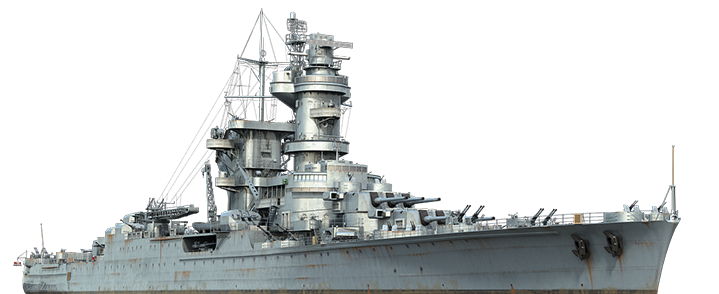
WoW rendition of Saint Louis
The heavy cruiser Algerie was considered the most successful of the “Washington cruisers”, a perfect technical compromise respecting the treaty. The admiralty planned for the ageing of the tranche of heavy cruisers of the Duquesne class to launch a new series, voted in 1939 when it appeared that the treaty was no longer respected by the belligerent navies (and was lifted de facto).
Therefore, the next class called “Saint Louis” which was to include four ships, was of a whole different level, with a standard displacement increased to more than 14,000 tons, and a main artillery of nine 8-inches in three triple turrets. This was the “French baltimore”, but with smaller dimensions and much lighter AA. Another innovation, the Saint Louis had to have a “mast-stack” taken from the Richelieu and had to be provided with a sonar and a radar, although retaining their seaplanes. With 202 meters long by 20 wide, armor increased to more than 210 mm in places, a tonnage at full load estimated at 16,000 tons, they were able to respond effectively to the German heavy cruisers of the Blücher class (1937).
In addition to their 8-in (203 mm) artillery, they had to carry four twin 100 mm and eight 37 mm also in turrets, the model of which will be used on escort and destroyers after the war. Their turbines coupled with 6 Indret supercharged boilers were to give them 130,000 hp for a top speed of 34 knots. Their construction was approved in April 1940, but their construction was never started nor approved, the campaign of France cut short there. If they had been built, they would probably have been put into service in 1943-44 and would have been very comparable to the Baltimore of the US Navy.
From 1935 it was more urgent to plan for the expected replacement for its 1920s Duguay Trouin class, by more modern ships. This was the trigger for Project C5, a heavy cruiser project, facilitated by the expected end of binding naval treaties. French naval engineers could really now search for the optimal design without compromises. They could propose the admiralty a fast, well armed and well protected ship like nothing before in the French Navy. The first C5 project was presented on May 12, 1939. It existed in two versions, with or without aviation, with a standard displacement of 10,349 or 10,246 tonnes, but both with the same nine 203 mm guns (8-in) as main armament, in three triple turrets. The secondary armament was planned to comprise 10 to 14 100 mm guns in twin turrets. As the design progressed with back-and-forth propositions with the admiralty, the C5 design reached 14,770 tW in April 1940, when it was approved by decree dated April 1, 1940. The construction of three ships was authorized.
Technically, these vessels were still quite close to the Algérie, seen retrospectively as a flush deck hull prototype. But they were much longer, reaching 194 up to 202 m overall. For construction, Welding was generalized but for only a few sensitive elements sensible to vibrations, which were still riveted. The choice of welding and light materials for the internal structures allowed more protection to be applied, thus, closing to an armored cruiser. Superstructures were much inspired from Algérie but with a more modern “mack” or mast-stack like for the Richelieu class behind the main bridge, and replacing the Algérie aft tripod. There was also an aft telemeter tower, combined into a new superstructure to house an AA platform.
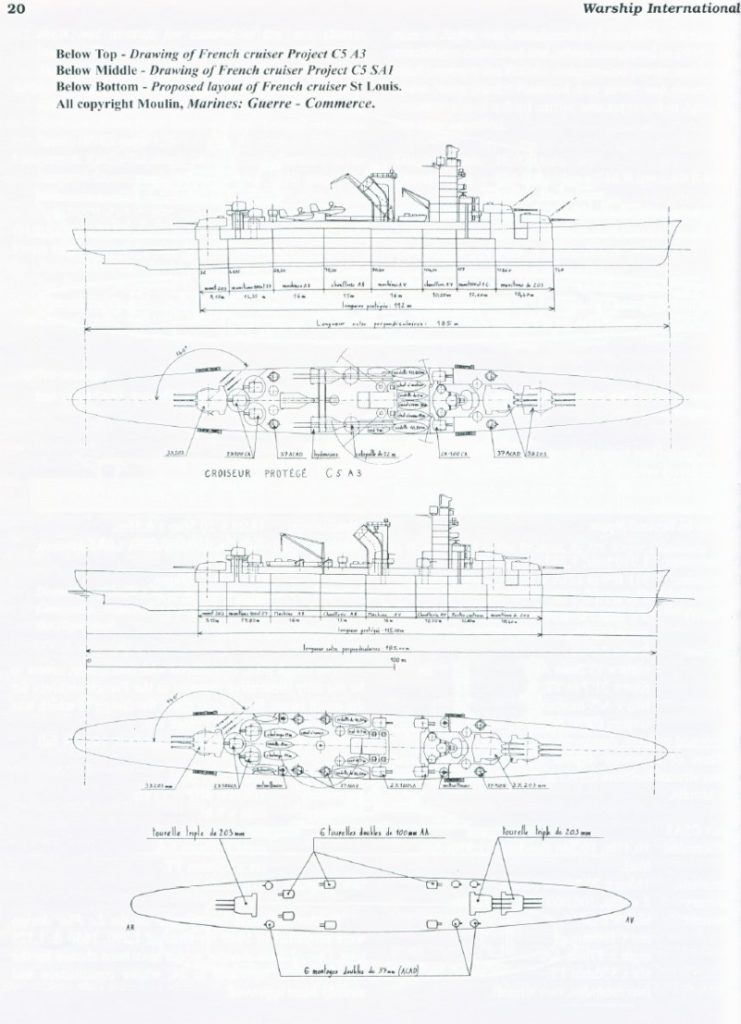
Renditions of the C5A1 and A3, basically with or without aviation. From Warships International, Jean Moulin.
The final C5 cruiser’s most striking arrangement was the choice of nine 203 mm guns in three triple turrets allowing one more gun to bear, plus sixteen 100 mm guns in eight twin mounts. The lighter AA was made up of six twin 37 mm mounts model 1935 and sixteen twin 25 mm Hotchkiss mountings. The project gained traction as it was hoped construction would proceed, and on May 15, 1940, a circular proposed names: Saint Louis for the lead ships, Brennus, and Henri IV, but also Charles Martel, Charlemagne, and Vercingetorix, all great classic figures and statesmen of French history. The Minister of the Navy eventually settled on Saint Louis, Henri IV, and Charlemagne.
Construction of Saint Louis was entrusted to Arsenal de Lorient, Henri IV to Ateliers et Chantiers du Havre and Charlemagne was attributed to the Ateliers et Chantiers de France based in Dunkirk. Little they could guess that the city would be under the Luftwaffe’s bombs and assaulted by a panzerdivision from 26 May, barely ten days afterwards !.
Originally they were meant to replace the Duguay-Trouins. Three more were ordered to be sent to the Mediterranean, expected to enter service in 1944.
Specifications:
Displacement: Initial Washington: 10,349 t (C5A3) or 10,246 t (C5SA1). 14,770 april 1940.
Dimensions: (Final CS5A1): 202 x 20 x 5.8m
Armament:
-3 x 3 x203/55 modèle 1937 (range 27,840 m, 10 rpm;
-5 (C5A3) or 7/6 (C5SA1) twin 100mm/45 modèle 1933, range 15,800/10,000m, 10-16rpm.
Planned replacement by the much faster automated 100mm/55 modèle 45 (Range 17,260/11,300m, 20-25rpm)
-4 (C5A3) to 6(C5SA1) quadruple 37mm/48 modèle 1935 (ceiling 8000m, 162rpm)
Planned upgraded, 57mm/60 m51 postwar (120rpm)
-8 twin 25mm/77 modèle 38, ceiling 1,800m, 250/300rpm
-2 x 4 533mm TTs, modèle 1935 torpedoes, range 13,000m/45n
-3 floatplanes on C5A3 variant.
Powerplant: 130,000 hp (Rateau-Bretagne turbines*, Du Temple boilers, 35 knots).
Armor: Possibly up to 21 cm belt. Details unknown.
*Likely Parsons models would be unavailable due to British requisitions

Author’s rendition of the St. Louis
DE GRASSE class light cruisers (1940)
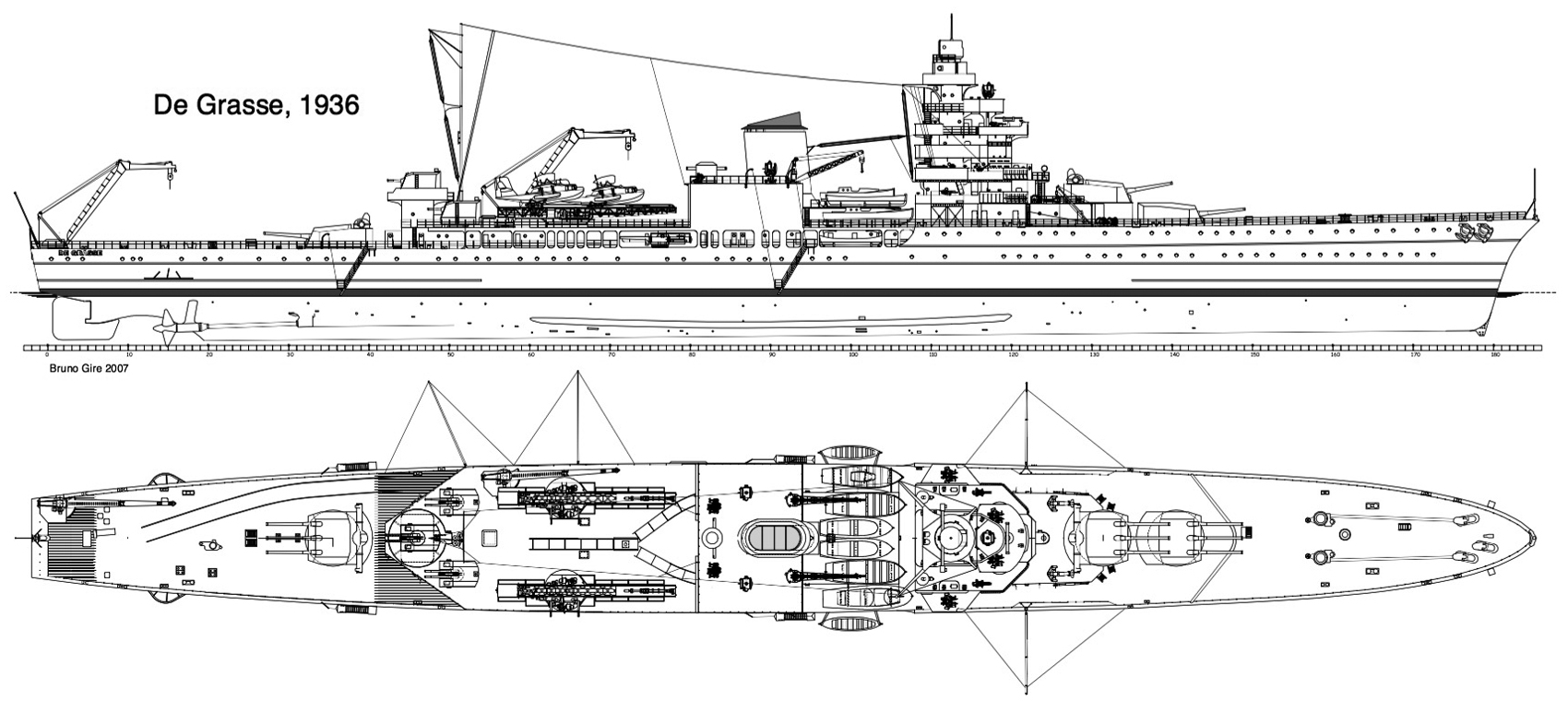
Rendition of the De Grasse blueprint in 1937.
The replacement of buildings of the Duguay-Trouin class, dating from the Vintg years, had been envisaged in 1936. Approved in 1937, the De Grasse class (also including the Chateaurenault and the Guichen), was ordered in 1938 and the construction of the De Grasse started at the Lorient arsenal in November 1938. In June 1940, with a lack of personnel and equipment, the construction of the hull was not completed.
In fact, the occupier authorized the Vichy regime to terminate it on its own account, but the staff being lacking, and for fear of recovery by the Germans, the works never succeeded. Work was resumed, on new plans, in 1948, and the De Grasse became an anti-aircraft cruiser in 1950, and had a long career, only being written off in 1976.
The De Grasse had to be better protected than the La Galissonière , while retaining the arrangement in three triple turrets of the previous buildings. Their anti-aircraft artillery included 6 pieces of 90 mm in three turrets (placed at the back), as well as 5 simple mountings of 25 mm of a new model, with rapid fire.
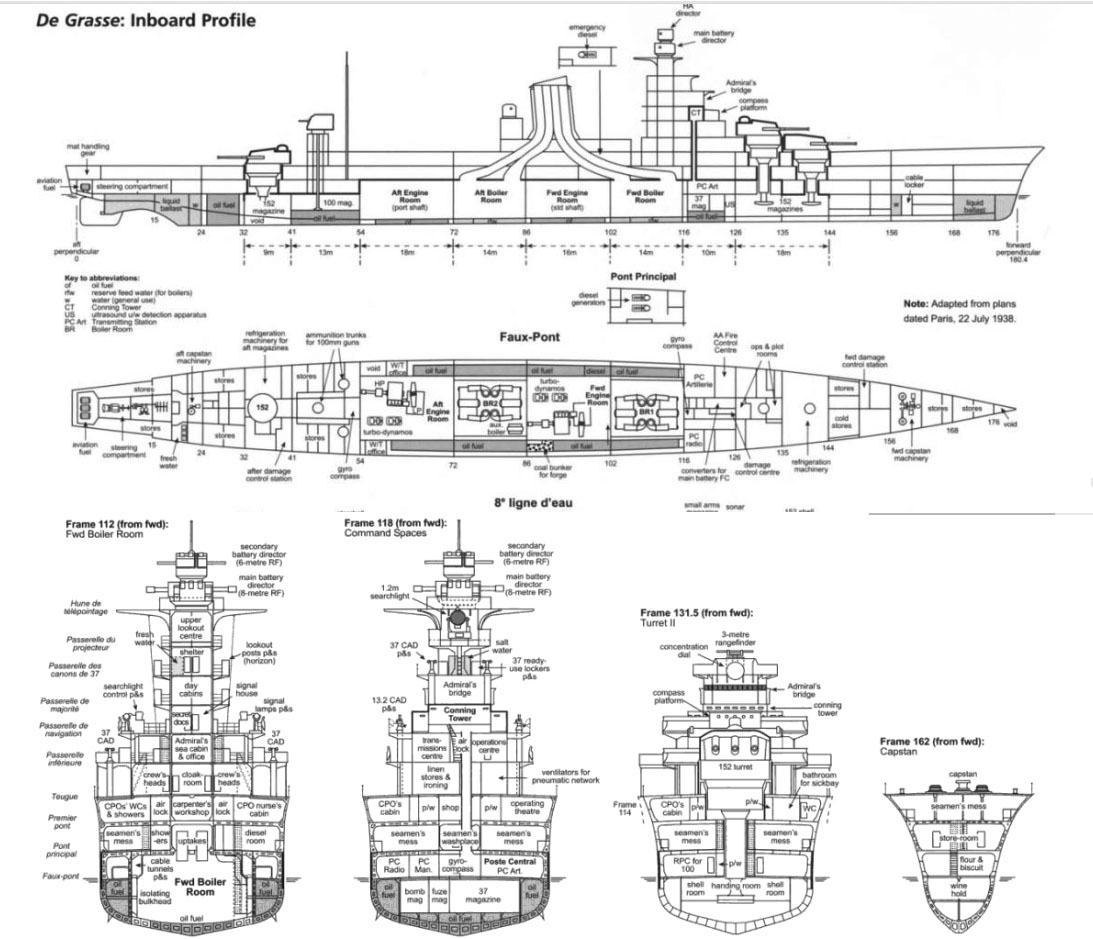
Cutouts schemes of the De Grasse – from “French Cruisers: 1922-1956”, John Jordan, Jean Moulin. Drawings by Jordan adapted from 1938 plans
In addition, they carried 13.2 mm quadruple carriages and two triple benches of 550 mm torpedo tube launchers. They had four additional seaplanes, including two Loire 130 observation vessels and two Laté 298 torpedo boats and ASM grenades. They kept their square bow, and their dimensions, although still compact, increased to 176 meters by 18 meters wide, and 9900 tonnes at full load. They had four propellers driven by as many Rateau-Bretagne turbines and four indret boilers for 110,000 hp and 33 knots.

Rendition of de De Grasse class
Other cruisers projects (1920-45)
This Appeared in the 1920 issue of the American Society of Naval Engineers, page 216. Several designs being considered by the “Conseil Superieur” are written down. These were the following:
- 5,300 tons 32knts, eight 5.5 inch 55 caliber guns
- 6,000 tons 35knts, eight 5.5 inch 60 caliber guns
- 7,600 tons 33knts, six 7.6 inch guns
- 8,500 tons 33knts, five 8 inch guns
In 1919 there were plans for a 4,750 tons cruiser with eight 5.5 inch guns and 30 knots speed, a follow-up of the Eclaireurs d’escadre of 1912
Fiction and reality: WoW’s fantasies
Friant
Friant was indeed a French cruiser name dating back from 1896. The name could have been used on the initial 1920 project, one of the preliminary designs before the blueprints of the Duguay-Trouin class were drafted. The design is consistent with the early designs that already regarded superfiring twin turrets as a solution. However in the game, the low speed was not reflecting the tendency already started in 1912 with the projected scout cruisers. Now the other French cruisers presented by this video game:
Charles Martel
The Martel is classed lower than the St Louis because of its tonnage. This was a heavy cruiser project (labelled “Project C5A3”) aimed at the German heavy cruisers of the Hipper class but also in the context for future treaties expirations and denunciations. This was the first model with triple turrets. The St Louis then should be a derivative or evolution incorporating more armour. At that point in 1938-39 it was clear that in case of war, the belligerents would enter with treaty-capped compromised vessels. Although it is not sure French intelligence at the time knew about the real displacement figures, nobody wanted to be sending its sailors on death-traps. So provisional projects were voted and when wartime broke out, several “un-capped” cruisers designs were studied. The experience gained with the La Galissonière class and seeing navies around the world carry on with triple turrets showed the way forward. It seems to have been the early 10,000 tons (Washington)
Saint-Louis
This one is totally legit and well-known. See the dedicated topic. It was the C5A1 version (with aviation) which was retained.
Henri IV
According to WoW, “it was developed from the preceding projects” (aka C5 cruisers) “with enhanced anti-aircraft defenses, and carried 240 mm main guns designed in the 1930s.” According to naweaps.org, there is simply no entry in the 240 mm category. And it’s quite doubtful a reuse of the old 24 cm/50 (9.45″) Model 1902-1906 already used on the Danton class battleships as secondaries, even modified with new breech blocks and mounts. In the interwar, the Danto class were in reserve, but still armed. Extra guns would have been kept for spares. So for this “1930s 24 cm gun”, we should consider this one a pure fabrication. As for the name, Henri IV really existed, she was one of the serie of six Saint Louis class, second batch, and would have been a repeat of the C5A1/3 design.
A point on French cold war cruisers
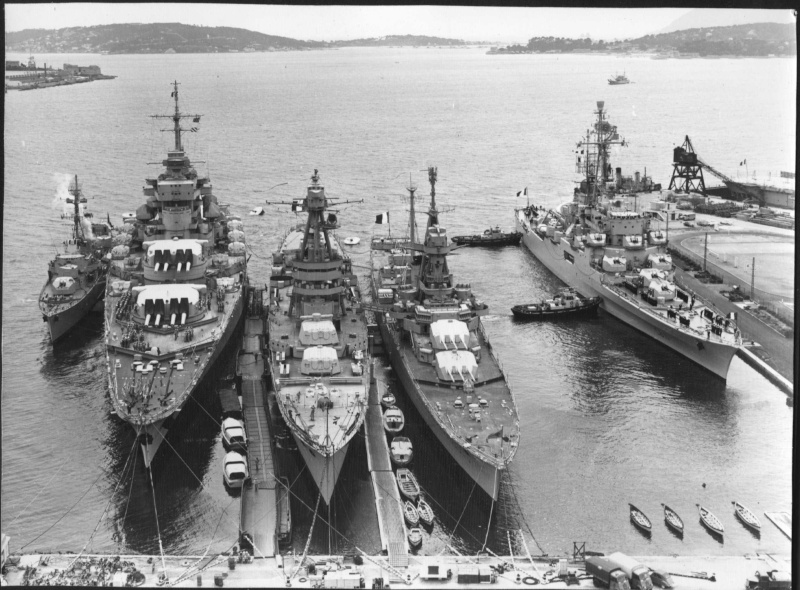
An impressive sight, Toulon in the 1960s: Left to right, the battleship Jean Bart, the cruiser Suffren (disarmed), Montcalm, and behind, the still active colbert.
Basically post-war France had still two WW2 cruisers in reduced service until 1970: Océan (ex-Suffren, accomodation ship 1962, discarded 1974), and Montcalm (same from 1958, discarded 1970) modernized in the 1960s with modern radars and AA, but the Frecnh Navy only had two modern ‘conventional’ cruisers, also in service in 1970 and similarly armed: The De Grasse & Colbert. Former cruisers were discarded in the 1950s (Duguay Trouin, Duquesne, Jeanne d’Arc, Emile Bertin, Gloire, G. Leygues) with the exception of Tourville (discarded 1962).
Of the 1940 De Grasse class, only one was completed, but due to the war, all work came to an abrupt stop and the design was completely, entirely revised for a pure AA cruiser, well rendered by WoW. Even that concept had a limited usefulness, but for the very early jets, given the fact this powerful AA artillery was medium to long range. In 1960, SAMs were all the rage. So Colbert was rapidly converted whereas De Grasse stayed in her original configuration, but modified to take on more specialized role (base ship in the Mururoa pacific nuclear test facility).
World of Warships shows an hypothetic “Bayard” which is allegedly based on a project from 1945 regarding a light cruiser carrying 4 triple turrets with 152 mm guns. Thsis pathway was abandoned in January 1948 to concentrate on a more useful pure AA cruiser, used to protect French CVs. No source is specifically cited, but it present an alternative early completion design for the De Grasse class, using original De Grasse artillery, but with four triple turrets and a more advanced AA and a roomy superstructure closer to the 1950s projects. A right comparison would be the Soviet Chapayev and Sverdlov classes.
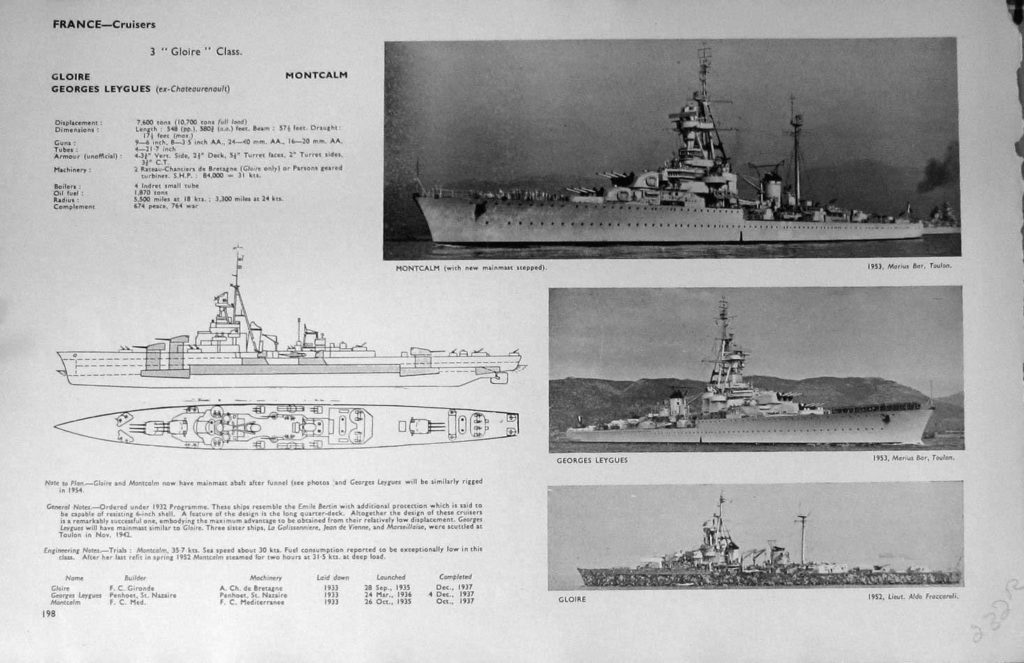
ONI Recoignition plate of the Montcalm, as she was in 1953 after her refit. Notice the new tripod mast supporting a new set of US-built radars and WW2 era AA.
Read More/Src
Conway’s all the world’s fighting ships 1922-47
French Cruisers 1922-56 Google Books
http://forummarine.forumactif.com/t3862p30-une-marine-francaise-alternative
http://fr.naval-encyclopedia.com/2e-guerre-mondiale/marine-francaise2egm.php#crois
Nomenclature of French WW2 cruisers
In September 1939, the French Navy aligned 19 cruisers: In chronological order: The three Primauguet, the two Duquesne, the four Colbert, the Pluton, Jeanne d’Arc, Emile Bertin, Algérie and the six La Galissonnière, not the last French conventional cruisers in service (This would be the new Colbert and Suffren). One was lost in an accident, one beached (1942), on sunk in 1945 and seven scuttled in Toulon in 1942. The drama of their active life was of course dictated by events. Of the few which actually fired in anger, were against British and US targets during operation Torch, ground objectives in 1944 (France, Italy…), the Thai Navy (in 1941) and Indochina in 1949-50. Of the ships that survived, the last was Suffren, renamed Océan in 1964 and BU in 1974.
Primauguet class (1922)

Lamotte-Picquet in Shanghai, circa 1939. Left is the British light cruiser Birmingham’s tern and bow of the U.S. Navy troop transport USS Chaumont, right. Also spotted in the frame are the Danish steamer Promise British steamer Yingchow (right background), British steamer Shantung (right foreground) Src Official U.S. Navy photo NH 81987 from the U.S. Navy Naval History and Heritage Command.
The three light cruisers of this class, including the Duguay-Trouin, Lamotte-Picquet and Primauguet, were the first French cruisers built since 1906. The war had sold the resources of the French naval industry, but in 1920, They had recovered their potential, partly in part because of the war damage imposed on the Germans, and uninterrupted and consequent efforts. The design of Omaha class ships, as well as those of other navies, was carefully studied, with Italy as a rival. The definitive design C was stopped in 1922.
Design
The hulls of these ships have been carefully studied to take full advantage of the available power of modern triple expansion boilers associated with turbines. The speed of 33 knots had been considered as soon as the plans were drawn. Their 155 mm guns of the 1920 model, a weapon from army stocks, (the standard was 152 mm), which amounted to 26,100 meters for 4 bursts per minute, which was relatively slow at the time , and was even more so in 1939.
A protection against combat gases had been envisaged, the turrets were thus conceived as hermetic. The protection was the poor child of this design, with however a very strong subdivision around the engine room, and a sufficient protection of the roof of the turrets. The trials were successful, with these ships easily exceeding 34 knots, and able to maintain 30 knots with half of their boilers for more than 24 hours, which at the time was a good performance. However, their AA was sufficient for the time, but totally inadequate in 1939, and their range was low (6000 km at 14 knots) which was barely enough for fast sorties in the Mediterranean.
The Primauguet class in operation
All received seaplanes and associated catapults. First LGL32 (loire Gourdou Lesseure) then the Loire 130.
The Primauguet was rearmed in 1942 with a superior AA, as well as the Duguay-Trouin, passed to the allies in May 1943, then rearmed in an American arsenal. Radars, equipment and AA were at the American standard. The latter, under the command of Admiral Godfroy, was interned in Alexandria in 1940. Donated to the FNFL (Free French Navy), the cruiser participated in the campaigns of the allies, including operation Anvil Dragoon. She was scrapped only after the war, after some service in Indochina.
Duguay-Trouin
Duguay-Trouin (completed 2 November 1926) served in French Indochina in 1931 and from 1939, patrolled the Atlantic, looking for German shipping and commerce raiders. From May 1940 she was sent to the Mediterranean Sea, and ended in Alexandria with Force X when France surrendered. Thanks to a gentleman agreement between the two admirals, Force X was ‘demilitarized’ (breech blocks were removed and stored into a guarded, locked room) and stayed idle with only minimal staff for three years. From August 1943, the FNFL was attributed the ship and started to modify her, removing her torpedo tubes and augmenting her AA with fifteen Oerlikon 20 mm cannon and six twin 13.2 mm. In 1944 it was modified again to twenty 20 mm, six Bofors 40 mm guns and radar installed. Duguay-Trouin assisted Operation Dragoon in August 1944 and was part of the Flank Force, shelling German positions in Italy. After the war she was sent in Indochina, shelling coastal Viet Minh positions. Back to France, she was scrapped on 29 March 1952.
Lamotte-Picquet
Lamotte-Picquet was sent in 1935 to Indochina. She was part of Cam Ranh’s squadron, the “occasional group” near Saigon under Capt. Bérenger, and participated with two colonial avisos (sloops) and two corvettes, to the battle of Koh Chang, playing the instrumental role in destroying the Thai navy in January 1941, on paper with two armoured ships armed with 8-in guns. In December 1941, the Japanese demanded her disarmament and she was interned in saigon. She was finally sunk in January 1945 by Task Force 38 aircraft.
Primauguet
The Primauguet as soon as she entered the service, made long cruises of several months. In 1932, she was sent to Indochina, then he was replaced by the Suffren, and then escorted the French convoys to the Atlantic from 1939. In May 1940, he was at Fort de France, raising the Jeanne d’Arc; Then he went to protect the Dutch Indies. In June 1940, he was back in Dakar. He helped transport some of the Bank of France gold stocks to Africa. While escorting a tanker departing to supply the 4th squadron of cruisers in Libreville, he was intercepted by HMS Cornwall and Delhi.
After negotiations, she was forced to turn around. In November 1942 she was in Casablanca, undergoing a major overhaul. During Operation Torch she fired at USS Massachusetts which soon replicated (as well as on Jean Bart). Ther was little she could not do with an almost non-existent protection, and after several salvoes from the American battleship she was left with 45 dead and more than 200 wounded. She moved out of range, burning and adrift, was beached, and declared the next day as a total constructive loss. The rest of the crew escaped and she was scrapped after the war in situ.

The Primauguet at the battle of Koh Chang.
Specifications
Displacement: 7,250 t. standard -9350 t. Fully Load
Dimensions: 181.3 m long, 17.50 m wide, 6.15 m draft.
Propulsion: 4 propellers, 4 Parsons turbines, 8 Guyot boilers, 120,000 hp. Maximum speed 34 knots.
Armour: 20 mm belt, 15 mm anti-torpedo partitions, bridge 20, 30 mm turrets, 30 mm bunker.
Armament: 8 x 155 mm (Model 1920), 4 × 75 mm AA, 4 × 3 550 mm TTs, Loire 130 seaplane.
Crew: 690
Duquesne class (1924)

Duquesne 1943
Description
The Duquesne and Tourville were the first heavy cruisers from the Washington Treaty in France, and the first since 1906. Preceded in 1923-24 by the three Primauguets (light cruisers), these vessels were wider, had classical “Washington” main artillery of eight 8-in (203 mm) all with a tonnage of less than 10,000 tonnes. Out of rivalry with the Italian Navy, emphasis was placed on speed. From the start a speed of 32-33 knots was required. During sea trials, she managed to reach 34 knots, but the maximum “normal” speed was 33.5 knots. With 191 meters long, a length/width ratio of 1:10, the 10,000 standard tons could only be respected at the cost of a very light construction, to the point that their action in the North Atlantic was only a time not even considered.
Design
The construction was rational, with a military mast supporting the firing direction at the front, a gangway lined with an admiral bridge surrounding the blockhouse, ASM protection in caissons, light armor (30 mm) around the turret wells. 203 mm, a reduced belt, torpedo tubes, a DCA which was then considered sufficient, and reconnaissance seaplanes launched from the deck of the rowboats. The lack of shining armor indicated that in the event of combat against other ships of the same class, they would have absorbed the blows without being able to bear them. But their philosophy was primarily based on the tactical use of speed, as well as for battle cruisers. Their Creusot guns just out of the arsenals allowed a range up to 31,000 meters, which at the time put them “out of reach” of most cruisers. They fired up to four rounds per minute, which was also very honourable for the time.
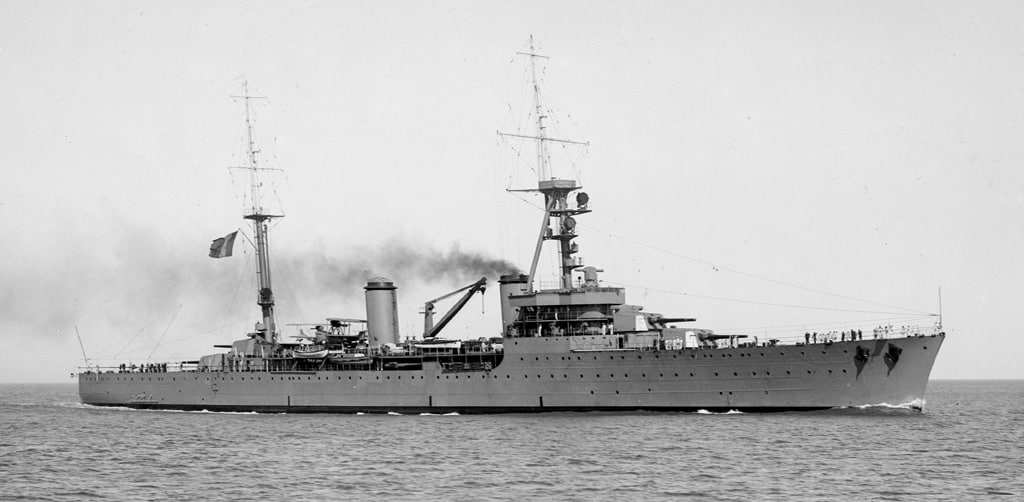
Duquesne in 1944, after its passage in US arsenals. Note the two-tone hull camouflage
The Duquesne class in operation:
They hardly had the opportunity to prove their military value. Indeed by June 1939, after having served with escorts in Mediterranean, the two ships were immobilized for a short refit;
Duquesne from September 1939 was assigned to one of the South Atlantic hunting groups searching for KMS Admiral Graf Spee. Tourville meanwhile patrolled for eventual German ships in the Mediterranean. Both were eventually assigned to Force X in the Mediterranean. In addition to the two sister-ships, the squadron comprised also the old battleship Lorraine, the Suffren, light cruiser Duguay-Trouin, the destroyers Basque, Forbin, and Fortuné, and the submarine Protée.
Admiral Godfroy’s squadron departed Toulon on 25 April 1940, and made it in Alexandria on 24 May. In June, Italy declared war on France, justifying their presence at Alexandria where they could operate with the Royal Navy. In July 1940 however, after the fall of France, the fat of the French fleet was immediately put into question. 4 July 1940 PM Churchill’s secret order Operation Catapult had all French ships captured or destroyed if necessary. However due to a gentleman agreement between Godfroy and Cunningham which knew each other well and even had family alliance, spared both fleet a futile bloodbath and destruction to the city. A complete contrast with Mers-El-Kebir. It was agreed to empty fuel fro their bunkers and retire the breech block mechanism, while the remaining crews would not attempt to escape and in exchange would be repatriated at the shortest notice.
The ships stayed idle until mid-1943. Darlan (assassinated in between) indeed had swapped sides to the allied on North Africa, and so did the remainder of French ships. it was decioded to send both heavy cruisers for a refit in the United States. Their torpedo tubes, catapults and aircraft were removed, and they received eight Bofors 40 mm guns and sixteen Oerlikon 20 mm for AA. From then on, they would patrol the mid-Atlantic, looking for Axis blockade runners. Due to heir light AA, they were denied to participate in the invasion of Normandy. Duquesne however joined the Task Force sent in December 1944 to shell coastal pockets of German resistance. Both would be sent in 1946 in French Indochina, part of the task force deployed for counterinsurgency. Both were paid off in 1950 after their return to France, and BU in 1955 and 1962 respectively.
Specifications
Displacement: 10,000 t. standard -12 200 t. Full Load
Dimensions: 191 m long, 19 m wide, 6.3 m draft.
Propulsion: 4 propellers, 4 Turbine turbines, 9 Guyot boilers of the Temple, 120,000 hp. Maximum speed 33.7 knots.
Armour: 30 mm belt, 30 mm anti-torpedo partitions, 25 bridge, 30 mm turrets, 30 mm bunker.
Armament: 8 pieces of 203 mm cal.55 (Model 1925), 8×76 mm DP, 8×37 mm AA (4×2), 8 ML of 13.2 mm AA (2×4), 2 Loire 130 seaplanes.
Crew: 605

Tourville in 1939. Well designed, these ships however had a protection sacrificed to speed.
Suffren class (1927)
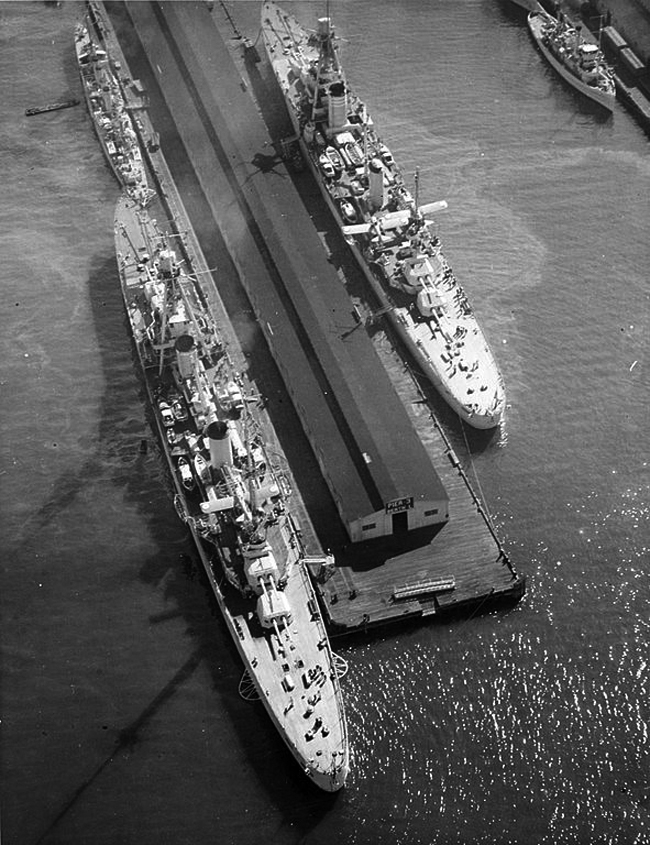
Overview of the Suffren and Duquesne in Port 15 October 1934, photo from USN scouting fleet. There is a U.S. Navy Wickes/Clemson-class destroyer tied up in front of Duquesne. (cc)
More armour, less speed
The Suffren class succeeded to the Duquesne class cruisers, ordered from their launch on the same basis, 10,000 tons washington heavy cruisers. Laid down between 1926 and 1929, they were launched between 1927 and 1930, entered service between 1930 and 1932. In outline, they were closely derived from Duquesne, with slightly larger dimensions in length, width and draft and with a significantly better protection (though still very light). The belt, for example, was increased to 65mm, which was still too weak to stop most projectiles and torpedoes. compartmentation was more advanced, allowing medium and light projectiles to lose velocity before reaching the most sensitive parts, although delayed fuses became widespread at the same time, making these dispositions soon obsolete.
Their speed, with a slightly different machinery arrangement rested on three shafts. Top speed was less impressive than Italian cruisers, always displayed exceptional performances. The class included the Suffren, Colbert, Foch, and Dupleix. They varied slightly in size (Foch was larger) and their anti-aircraft artillery was now composed of the new 88 mm mounts, varying slightly in details from one ship to another. Sufficient in 1935, this AA was no longer relevant in 1940.
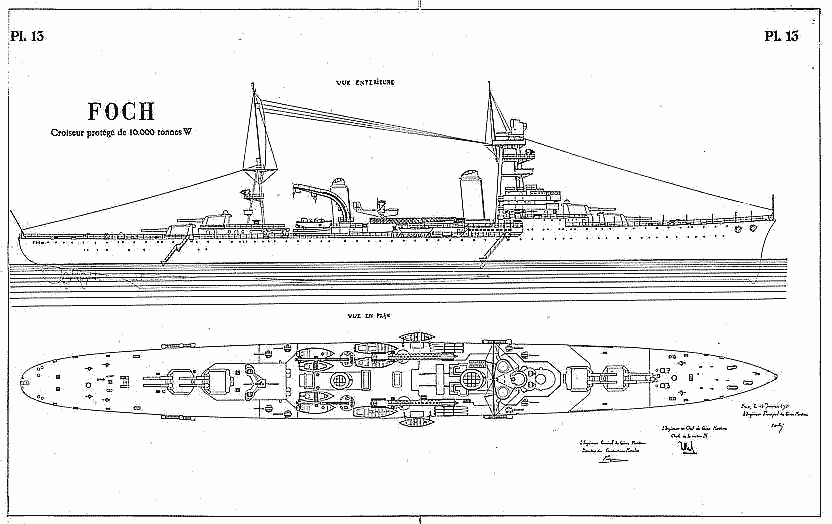
All the plans of Foch and Suffren class cruisers >
The Suffren class cruisers in operation:
The history of these four ships was relatively short (apart Suffren) During the conflict, these vessels were active, searching for the Graf Spee in the South Atlantic and the Indian Ocean.
In June 1940, Suffren was in Alexandria with Force X while her sisters were in Toulon. She was interned, partially disarmed under British control. She waited there until May 1943 and passed under the control of the FNFL (Free French Naval Forces). She was sent to New York for a major overhaul anti-aircraft rearming to US standards she emerged anew.
Suffren was then sent to reinforce the Franco-British squadron of the Far East alongside the Richelieu, participating in mainly coastal support missions. She would return home, to return after the war in Indochina. In 1962, she was placed in pre-reserve and served as a floating pontoon under the name Ocean in 1964 (to clear the name for a new missile cruisers). She was BU in 1974, a good career for a ship designed in the late 1920s.
Foch, Dupleix and Colbert stayed in Toulon most of their time of service, making only rare sorties due to fuel rationing. They were all three scuttled in November 1942. Dupleix was refloated in July 1943 by the Italians who wanted to repair and integrate her in the crippled Regia Marina. Repair work was slowed down by the French workers, and never was completed. The ship was sunk by an American air raid during the landing in Provence (operation Anvil Dragoon).
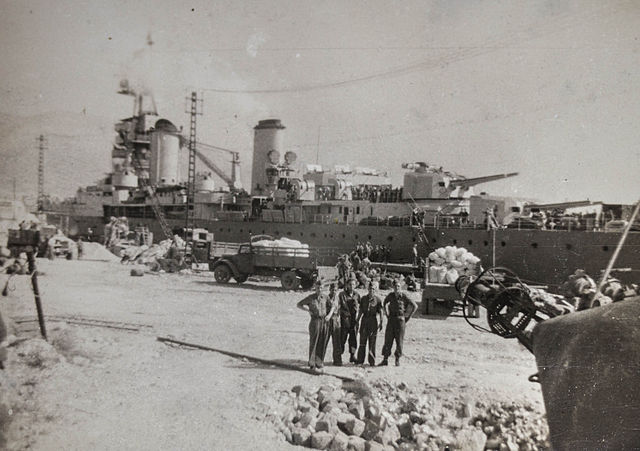
Cruiser Suffren at Toulon 21 Sept. 1945 – Personal archive by André Marton (cc)
Specifications
Displacement: 9,980 t. standard -12,780 t. Full Load
Dimensions: 194 m long (196 Foch), 19.3 m wide, 7.2 m draft.
Propulsion: 3 propellers, 3 Turbine turbines, 9 Guyot boilers of the Temple, 90,000 hp. Maximum speed 31 knots.
Armour: 65 mm belt, 25 mm anti-torpedo partitions, 25 bridge, 25 mm turrets, 28 mm bunker.
Armament: 8 pieces of 203 mm cal.55 (Model 1925), 8×88 mm DP, 8×37 mm AA (4×2), 12 ML of 13.2 mm AA (2×4), 2 Loire 130 seaplanes.
Crew: 750

Colbert in 1939. The four Suffren took over the defects of the previous Duquesne in terms of protection, and while they were completed, the Italians had the Zara class in construction, much better protected. Another HD Photo of the Foch (uncertain source)
Algérie (1930)
Algérie arrived after a series of cruisers which had been criticized for their cruel lack of protection and their too light construction. We came to study under a new direction, a new type of heavy cruiser still subject to Washington tonnage, but trying this time a compromise clearly focused on protection.
design:
This resulted in more modest dimensions, a flush-deck hull, revised interior fittings, but almost unchanged speed, and all this was in favor of excellent general protection. It was in fact, even in the international opinion undoubtedly one of the most successful if not the most successful of the “wahington cruisers”. Laid down in 1931, it was launched in 1932 and operational in September 1934.
Algérie in operation:
Despite its qualities, Algeria was never really put to the test. Assigned to the first cruiser squadron (with the Fochs, Tourville, Duquesne, Colbert and Dupleix), he was detached from Toulon to operate the pursuit of the German privateer Graf Spee in the South Atlantic. He was therefore based in Dakar. In March 1940 he escorted the battleship Bretagne, putting French gold (3000 tonnes of ingots) in safety in Canada.
After the Italian declaration of war, she was sent to pound the facilities of the port of Genoa. He was on an escort mission when the capitulation came. Wet in Toulon, escorting Provence from Mers-El-Kébir after the attack. In 1942, a radar and a better AA battery were added to it. But on November 27, she was scuttled in Toulon, like the rest of the fleet.
Specifications
Displacement: 10 000 t. standard -13 641 t. Pleine Charge
Dimensions: 186,2 m x 20 m x 6,15 m draft
Powerplant: 4 x Rateau-Bretagne turbines, 6 Indret boilers, 84 000 ihp. Top speed 31 knots.
Armor: Belt 120 mm, 70 mm ASW bulkheads, decks 80 mm, 95 mm turrets, blockhaus 95 mm.
Armament: 8 x 203 mm cal.55 (Mod 1931), 12 x 100 mm DP (6×2), 8 x 37 mm AA (4×2), 16 x 13,2 mm AA (4×4), 2×3 TT 550 mm, 3 seaplane Loire 130.
Crew: 748
Emile Bertin (1930)
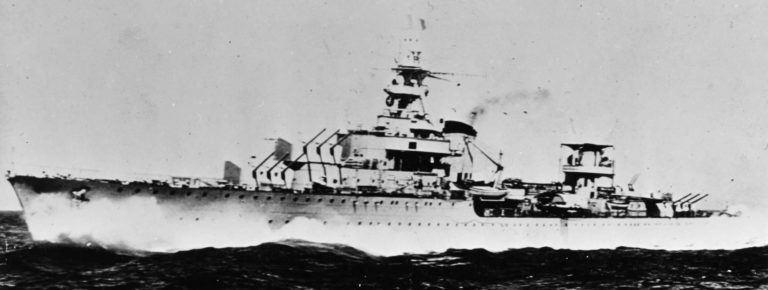
Official U.S. Navy photo NH 88990 from the Naval History and Heritage Command
The breakthrough French cruiser
Named after a famous French naval engineer, Emile Bertin, this light cruiser of the new generation innovated in the same way that Algeria had marked a clear break for heavy cruisers. Basically, she was designed to support the Pluto (later renamed “La Tour d’Auvergne”) as a minelayer cruiser and heavy destroyers leaders of the like of Malin or Maille Breze class in the Atlantic.
Design
Slightly built (she was even reinforced to allow firing in simultaneous side bursts), its hull was very studied to give it an advantage of speed and fuel economy. As such, a very good walker, he was also particularly fast, reaching 38-39 knots for testing (the rival Italian rivals of the Band Nere class on their side claimed 41-42 knots). He was especially the first to use triple turrets of 152 mm guns, in order to save armor and weight in general. In this way they managed to have 9 pieces. Bertin will serve as a test gallop for the famous next class, La Galissonnière. It was built at the Penhöet (Saint Nazaire) shipyards, launched in 1933 and completed in 1935.
Emile Bertin in operations:
In 1939, Bertin was transferred from the Atlantic to the Mediterranean, then based in Toulon, still in his role as a flotilla leader. He secretly delivered the gold reserves of Poland to Lebanon. After a short remake, he left to patrol around the Canary Islands. Then in April 1940 he was back in Brest, where he was assigned to Group Z for Norway under Admiral Derrien. In Namsos he was attacked on April 19 by the Stukas of the Luftwaffe and had to return to Brest for repairs. Subsequently, he was sent with a gold stock from the Bank of France in Nova Scotia, Halifax, along with Jeanne d’Arc and Béarn.
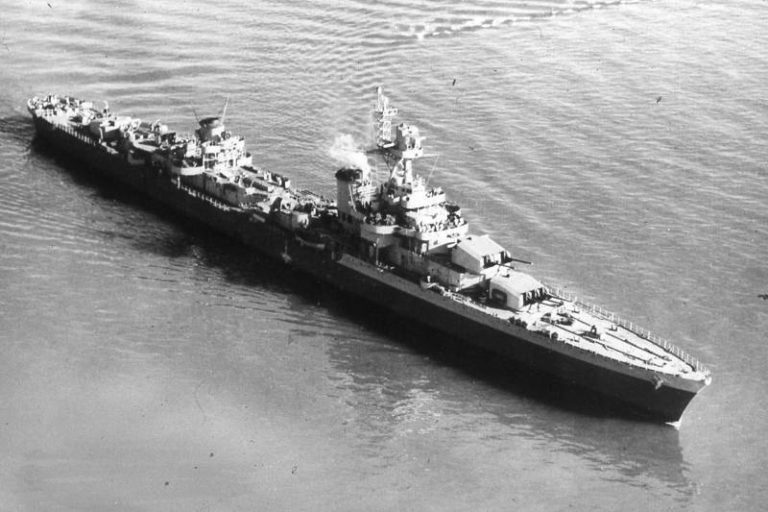
The Bertin in 1944. Note his equipment revised to US standards and the standard camouflage of that time. U.S. Navy’s recognition slide. (cc)
Meanwhile the news of the capitulation arrived. Emile Bertin was then sent to Martinique and inactive, then partially disarmed in May 1942. In June 1943, he was officially handed over to the FNFL and joined the arsenal of Philadelphia to be rearmed and re-equipped to the standards of the US Navy. He was then sent to participate in the Italian campaign and landing in Provence. After 1945, she participated in the operations in Indochina, before being disarmed and sent to scrap in 1959.
Specifications
Displacement: 5,880 t. standard – 8,840 t. Full Load
Dimensions: 177 m long, 16 m wide, 6.6 m draft.
Propulsion: 4 propellers, 4 Parsons turbines, 6 penhöet boilers, 102,000 hp. Maximum operational speed 34 knots.
Propulsion: 20 mm belt, 18 mm anti-torpedo partitions, bridge 20, 26 mm turrets, 26 mm blockhouse.
Armament: 9 pieces of 152 mm cal.55 (3×3 – 1930 model), 4×90 mm AA, 8x37mm AA (4×2), 8×13,2 mm AA (4×2), 2 Loire 130 seaplanes.
Crew: 550

Emile Bertin in martinique, late 1942.
Jeanne d’Arc (1930)
The fourth namesake School cruiser
4th generation of French training ships bearing this name, the “Jeanne” was a new light cruiser specifically designed for this purpose, with sufficient internal layout for many cadets. (156 student-sailors and 20 officer-instructors) Starts at Saint Nazaire in 1928, launched in 1930 and completed in 1931, this vessel was derived from the design of Duguay Trouin, but only had a speed of 25 knots. Its autonomy, on the other hand, was much more important.
The “Jeanne” in action
In May 1940, this ship was in Brest, and rushed for Martinique. Declared neutral, then officially under the control of Vichy, the ship remained immobilized until June 1943. At that time, the US command accepted its transfer to the FNFL. A major modernization was undertaken in the USA. The ship lost its catapult, its torpedo tubes, and received American standard AAA, with two 40 mm quadruple lugs and 20 single 20 mm carriages, plus a radar. Its main campaign was conducted in Italy, protecting the convoys and supporting its troops on the ground. His career continued long after the war, replaced by the helicopter carrier of the same name. She joined the torches for the demolition in 1966.

Author’s illustration of Jeanne d’Arc 1940
Specifications
Displacement: 6,500 t. standard -8,950 t. Full Load
Dimensions: 170 m long, 17.70 m wide, 6.4 m draft.
Propulsion: 2 propellers, 2 Parsons turbines, 4 penhöet boilers, 32,500 hp. Maximum speed 24 knots.
Armour: 20 mm belt, 15 mm anti-torpedo partitions, 20 bridge, 26 mm turrets, 25 mm bunker.
Armament: 8 x 155 mm (model 1920), 4 x 75 mm AA, 4 x 37mm AA (2×2), 12 x 13.2 mm AA (6×2), 4 x 3 TLT 550 mm, 2 seaplanes Lgl-32.
Crew: 500 + 176 cadets
La Galissonière class (1934-37)
La Galissonnière, Gloire, Georges leygues, Montcalm, Jean de Vienne, Marseillaise
Closely derived from Emile Bertin and responding to Italian Condotierri class buildings, the La Galissonnières displayed 9 pieces of 152 mm in triple turrets. They were distinguished by more compact superstructures, a square stern, a more solid hull and reinforced protection. In the end they were heavier by almost 1000 tonnes, which was not negligible for their size.
No less than six vessels had been planned, which entered into service between 1935 and 1937. These were the last French cruisers before the De Grasse class (see projects).
These ships were compromises intended to guarantee at the same time a good speed, an imposing armament, and the adequate protection on a limited tonnage allowing for more ships. Their main sacrifice was their range, due to a reduced hull, but adaptated to the Mediterranean. In addition they were armed with 90 mm model 1926, probably the best AA of the French arsenal (12-15 rounds/minute, launching a fuse HE shell 9.5 kgs up to 15,000 meters) and had a flawless construction massively using welding. These ships were among the most beautiful assets of the fleet fleet in 1939, both in quantity and quality.

La Galissonnière in July 1940
Their long post-war career attests to this. Their 550 mm model 23DT torpedoes were efficient, with an offensive head of 310 kg of TNT, they weighed 2070 kg, measured 8.30 m and were able to hit a target at 9,000 meters at 39 knots. Their armor still used strong compartmentation, but the general thickness allowed in theory to withstand impacts from cruiser shells of the same caliber (152 mm), which was a first.
Their driving apparatus varied according to the units, between Parsons turbines (La galissonnière, Georges leygues, Montcalm) and Rateau-Bretagne (Gloire, Marseillaise, Jean de Vienne). Their nominal top speed was 31 knots, but some like the Marseillaise managed to maintain a speed of more than 35 knots.
All had four LGL 32 seaplanes (and later two Loire 130) housed in a hangar located in front of the turret back. The latter had a catapult to authorize their launch. The goose neck crane at the base of the aft mast was used to retrieve it and launch the boats. In the end, apart from their insufficient secondary DCA in 1939, the La Galissonnières were judged, in France and abroad, as particularly successful ships.
La Galisonnière-class cruisers in operation:
The La Galissonnière, Jean de Vienne and Marseillaise formed the 3rd cruiser division in 1939, based in Bizerte for the Mediterranean, and the other three, the 4th division based in Brest for the Atlantic. The 4th division was attached to the Raid Force in 1939, along with the Strasbourg, Dunkirk, heavy cruisers, and destroyers at Brest. They protected the convoys from the Atlantic routes and gave chase – without success – to the German corsairs. Montcalm replaced Bertin in Norway, to cover the French troops engaged around Namsos. Then in April 1940, with the bellicose attitude of Italy, it was decided to send the 4th division to the Mediterranean, the ships being based at Algers.
In June, they made two sorties to try – in vain – to intercept the Italian cruisers. The 3rd and 4th divisions received an order from the admiralty asking them to join the squadron of Mers-El-Kebir (the order was received in key by the Royal Navy and the squadron of Admiral Somerville, then in Negotiations with Admiral Gensoul, was forced to shorten the discussions. We know the rest.The six cruisers, arrived too late to take part in what would have been probably a Franco-British naval battle of a certain scale, diverted on Toulon.
In September 1940, the Vichy government asked the admiralty to strengthen Libreville (Gabon) where an attack on free France was planned. The 4th division was therefore sent on the spot. But in the meantime they learned that the oil tanker Tarn, escorted by the Primauguet, was intercepted and forced to turn around by the Royal Navy, and were therefore in their turn forced to divert and set sail for Dakar, without the Glory , slowed down by turbine problems and forced by the Royal Navy to return to Casablanca.
Georges Leygues and Montcalm therefore took part in the ultimately successful defense of the Vichy fleet against the combined Allied forces (Operation Menace). In June 1941, Glory joined them. They remained anchored on the spot until 1943 (Le Gloire left in September 1942 to try to save the victims of the liner Laconia, sunk by the U156. (For his part Jean de Vienne did the same with La Moricière off the Balearic Islands) The 3rd cruiser division was based in Toulon and their operational outings were practically impossible due to the lack of fuel oil.
In November 1942, things changed: Jean de Vienne, La Galissonnière and La Marseillaise were scuttled on the 27th, during the Lila operation. Two of them were later given to the Italians, renamed FR11 and FR12, but the salvage work and repairs were never successful. They were sunk by Allied raids in 1944 during the landing in Provence. For their part, the Dakar cruisers joined the allies. Before taking part in FNFL operations, they were sent for rearmament and retrofitting to US standards in Philadelphia and New York.
Glory, Montcalm and Georges Leygues thus participated in the Italian campaign, the landing in Provence (Anvil-dragoon), the landing in Normandy. After the war, they went to Indochina. They were then assigned to Toulon, re-equipped with more modern AA artillery and new radars. They were taken out of service in 1958 (Gloire), 1959 (G. Leygues), whereas Montcalm survived until 1970. She was considered for a while to be converted into a missile cruiser.

The cruiser Montcalm in 1944. Note the typical two-tone camouflage of the US Navy standard between mid-1944 and early 1945.

The cruiser Gloire in 1944. Note his famous camouflage in “railway accident”. In line with the naval camouflage experienced then, it was applied for the first time to a large tonnage vessel. The Glory, fully rearmed and re-equipped in 1943 at the arsenal of Philadelphia like its twins, had 6 quadruple 40 mm mountings (24 pieces) and 20 single 20 mm Oerlikons. Her aircraft equipment was removed as well as the hangar, canoes, masts and cranes.
Specifications
Displacement: 7,600 t. standard – 9 120 t. Full Load
Dimensions: 179 m long, 17.5 m wide, 5.35 m draft.
Propulsion: 2 propellers, 4 Parsons/Rateau-Bretagne turbines, 4 Indret boilers, 84,000 hp. Maximum operational speed 31 knots.
Armour: 105 mm belt, 120 mm anti-torpedo partitions, 38 bridges, 100 mm turrets, 95 mm blockhaus.
Armament: 9 pieces of 152 mm cal.55 (3×3 – 1930 model), 8×90 mm AA (4×2), 8x37mm AA (4×2), 8×13,2 mm AA (4×2), 4 TLT 550 mm (4×2), 2 seaplanes Loire 130.
Crew: 540
La Tour d’Auvergne/Pluton (1933)
A little apart, the cruiser Pluton was built as a training ship for the gunners and minelaying missions. She was assigned to Toulon and also served to train future officers of “La Royale”. In September 1939, Pluton has been renamed “The Tower of Auvergne” and was sent in Casablanca to prepare for a minelaying campaign. During an unfortunate manipulation when loading mines, one of them exploded ripping the ship apart and killing most of her crew in the blast, also damagin the surroundings and breaking windows in Casblanca. The wreck was in such a state that it had to be blasted again to disperse debris and clear off the harbor.

The “Auvergne tower” formerly Pluto, May 1929.
Characteristics:
Displacement: 4,773 t. standard – 6,550 t. Full Load
Dimensions: 152 m long, 15.60 m wide, 5.20 m draft.
Propulsion: 2 propellers, 2 Breguet turbines, 4 reduced tube boilers, 57,000 hp. Maximum operational speed 30 knots.
Armour: none.
Armament: 4 pieces of 140 mm under masks, 2x37mm AA, 12×13,2 mm AA (3×4), 290 mines.
Crew: 424


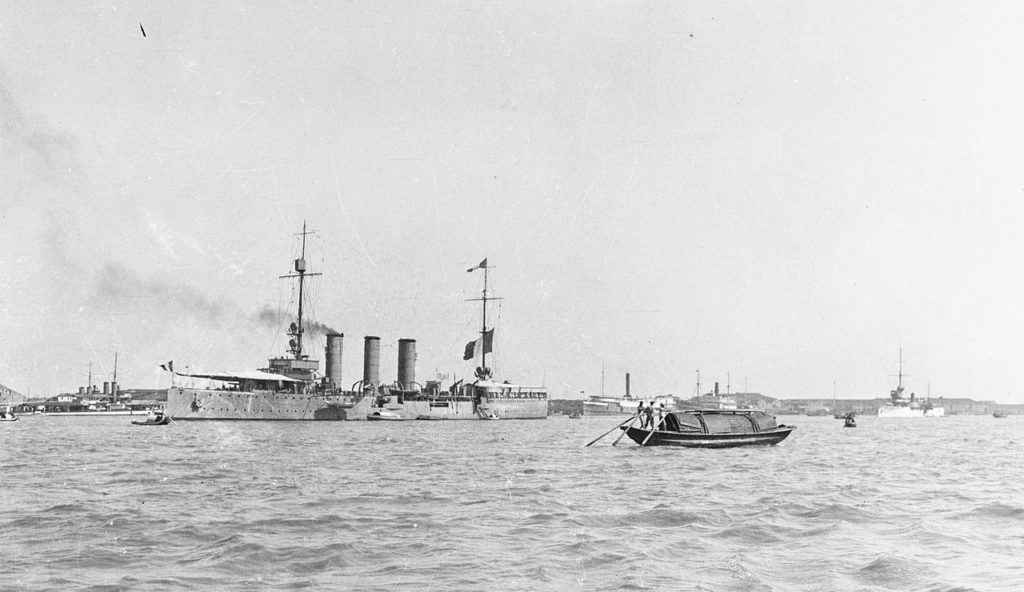
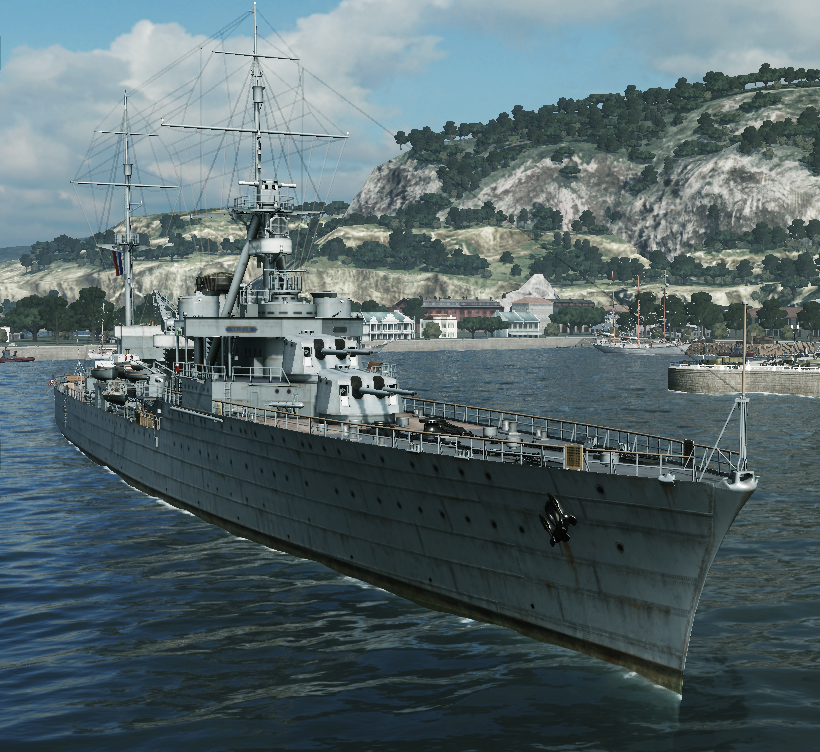
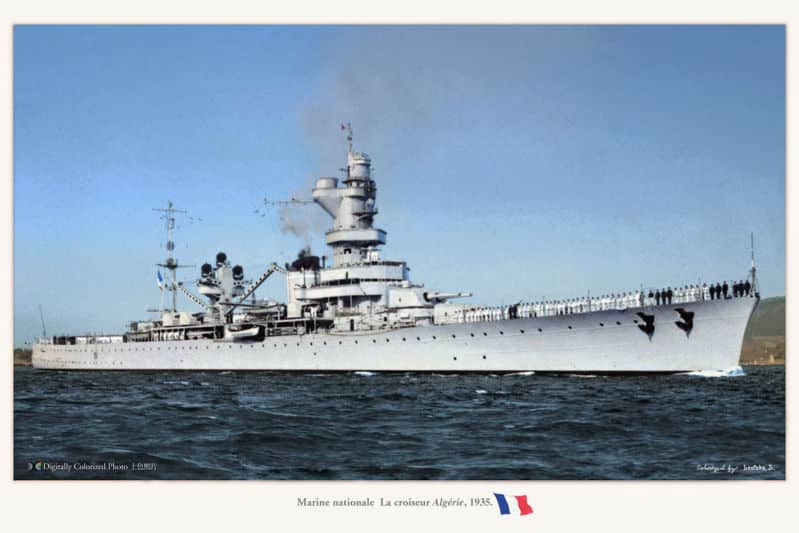
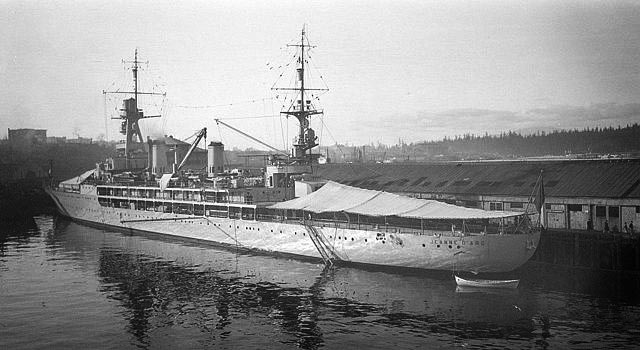
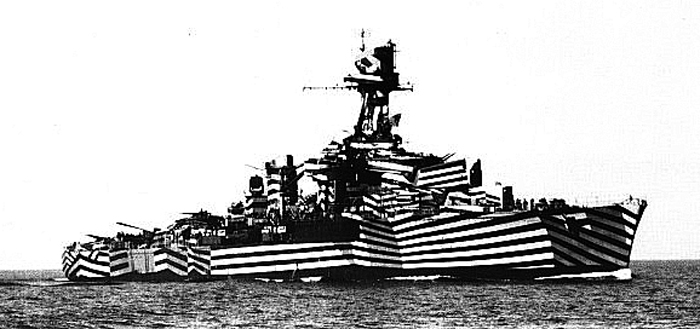
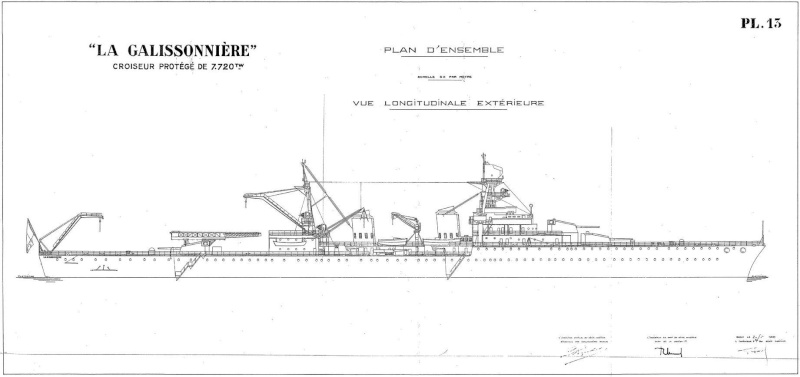
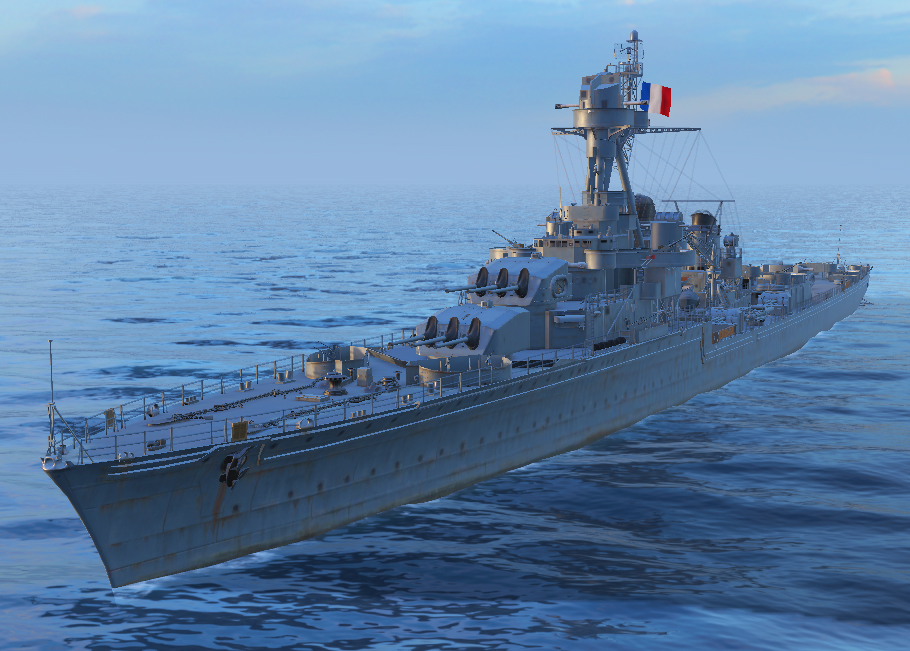


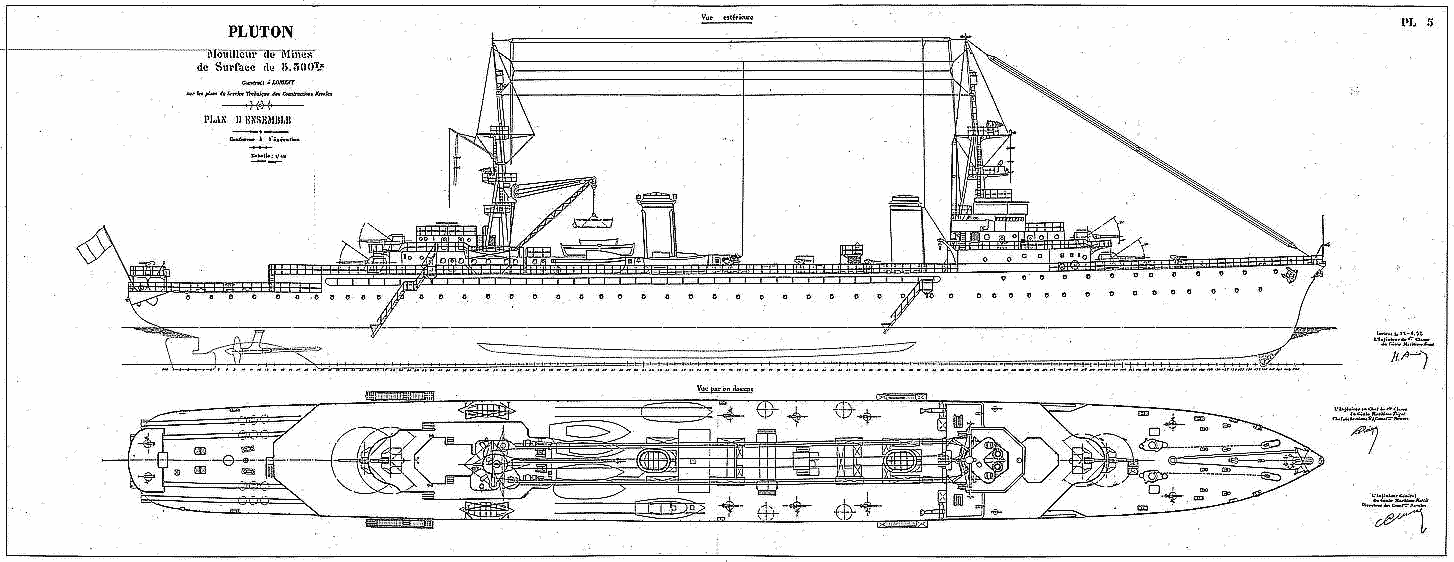
 Latest Facebook Entry -
Latest Facebook Entry -  X(Tweeter) Naval Encyclopedia's deck archive
X(Tweeter) Naval Encyclopedia's deck archive Instagram (@navalencyc)
Instagram (@navalencyc)





 French Navy
French Navy Royal Navy
Royal Navy Russian Navy
Russian Navy Armada Espanola
Armada Espanola Austrian Navy
Austrian Navy K.u.K. Kriegsmarine
K.u.K. Kriegsmarine Dansk Marine
Dansk Marine Nautiko Hellenon
Nautiko Hellenon Koninklije Marine 1870
Koninklije Marine 1870 Marinha do Brasil
Marinha do Brasil Osmanlı Donanması
Osmanlı Donanması Marina Do Peru
Marina Do Peru Marinha do Portugal
Marinha do Portugal Regia Marina 1870
Regia Marina 1870 Nihhon Kaigun 1870
Nihhon Kaigun 1870 Preußische Marine 1870
Preußische Marine 1870 Russkiy Flot 1870
Russkiy Flot 1870 Svenska marinen
Svenska marinen Søværnet
Søværnet Union Navy
Union Navy Confederate Navy
Confederate Navy Armada de Argentina
Armada de Argentina Imperial Chinese Navy
Imperial Chinese Navy Marinha do Portugal
Marinha do Portugal Mexico
Mexico Kaiserliche Marine
Kaiserliche Marine 1898 US Navy
1898 US Navy Sovietskiy Flot
Sovietskiy Flot Royal Canadian Navy
Royal Canadian Navy Royal Australian Navy
Royal Australian Navy RNZN Fleet
RNZN Fleet Chinese Navy 1937
Chinese Navy 1937 Kriegsmarine
Kriegsmarine Chilean Navy
Chilean Navy Danish Navy
Danish Navy Finnish Navy
Finnish Navy Hellenic Navy
Hellenic Navy Polish Navy
Polish Navy Romanian Navy
Romanian Navy Turkish Navy
Turkish Navy Royal Yugoslav Navy
Royal Yugoslav Navy Royal Thai Navy
Royal Thai Navy Minor Navies
Minor Navies Albania
Albania Austria
Austria Belgium
Belgium Columbia
Columbia Costa Rica
Costa Rica Cuba
Cuba Czechoslovakia
Czechoslovakia Dominican Republic
Dominican Republic Haiti
Haiti Hungary
Hungary Honduras
Honduras Estonia
Estonia Iceland
Iceland Eire
Eire Equador
Equador Iran
Iran Iraq
Iraq Latvia
Latvia Liberia
Liberia Lithuania
Lithuania Mandchukuo
Mandchukuo Morocco
Morocco Nicaragua
Nicaragua Persia
Persia San Salvador
San Salvador Sarawak
Sarawak Uruguay
Uruguay Venezuela
Venezuela Zanzibar
Zanzibar Warsaw Pact Navies
Warsaw Pact Navies Bulgaria
Bulgaria Hungary
Hungary

 Bundesmarine
Bundesmarine Dutch Navy
Dutch Navy Hellenic Navy
Hellenic Navy Marina Militare
Marina Militare Yugoslav Navy
Yugoslav Navy Chinese Navy
Chinese Navy Indian Navy
Indian Navy Indonesian Navy
Indonesian Navy JMSDF
JMSDF North Korean Navy
North Korean Navy Pakistani Navy
Pakistani Navy Philippines Navy
Philippines Navy ROKN
ROKN Rep. of Singapore Navy
Rep. of Singapore Navy Taiwanese Navy
Taiwanese Navy IDF Navy
IDF Navy Saudi Navy
Saudi Navy Royal New Zealand Navy
Royal New Zealand Navy Egyptian Navy
Egyptian Navy South African Navy
South African Navy






























 Ukrainian Navy
Ukrainian Navy dbodesign
dbodesign